Genus Geomalacus
Genus Granulilimax
Genus Hemphillia
Genus Kootenaia
Genus Magnipelta
Genus Letourneuxia
Genus Nipponarion
Genus Nipponolimax
Genus Pallifera
Genus Prophysaon
Genus Udosarx
Genus Zacoleus
Subfamily Binneyinae
Genus Binneya
Subfamily Ariolimacinae
Genus Ariolimax
Subfamily Anadininae
Subfamily Oopeltinae
Subfamily Arioninae
Genus Arion
Subfamily Ariolimacinae
 photo:Alex Wild
Ariolimax californicus Cooper,1872
Body light yellow,mantle concolorous.
Length 175-200 mm.
In central California.
A subspecies is A.c.brachyphallus,this slug has a shorter penis.
photo:Alex Wild
Ariolimax californicus Cooper,1872
Body light yellow,mantle concolorous.
Length 175-200 mm.
In central California.
A subspecies is A.c.brachyphallus,this slug has a shorter penis.
Ariolimax dolichophallus Mead,1943
Body light yellow,mantle concolorous.
Length 150-180 mm.
In coastal central California.
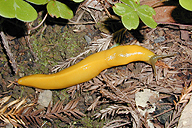 photo:© 2005 Eric Machleder
photo:© 2005 Eric Machleder
Ariolimax columbianus Gould,1851 Banana slug Body deep olive green,ochre,slate green,variable,with black spots varying from spots to blotches. Length 185-260 mm. In Alaska(Sitka),British Columbia,Washington,Oregon to California south the Salinas Valley. A subspecies is A.c.stramineus,this is in general a smaller thinner slug,is unspotted and has a smaller penis.There are also differences in the female reproductive organs. Its area of distribution is Ventura County;The Santa Cruz and Santa Rosa Islands off the coast northward to below the Monterey Bay.
Geomalacus maculosus Allman,1846
Animal grey,brown to black with many yellow or white spots,tentacles grey.
Foot brown with dark stripes across a narrow fringe,the center part of the sole is clear
with a yellow or grey band on both sides.
Length about 55 mm.
In Cork(Kerry);Ireland,Brittany,Northwest Spain and Portugal.
Arion rufus Linnaeus,1758
Formerly Arion ater and Arion rufus were considered species and subspecies but nowadays people generally consider them
two different species.The difference is only visible through disection:A.ater has a more slender genital atrium
than A.rufus.
The colour of the animal is not a useful aid in identification.Arion ater can be blackish to red and
Arion rufus can be reddish to blackish.
Arion lusitanicus Mabille,1868
Can also have different colors,greyish green,grey or brown,head and tentacles darker.
Length 70-100 mm.
In England,Portugal,France,Switzerland.
Arion fasciatus Nilsson,1822
A light colored slug,paler on the sides,pale grey to darker grey.
The lateral stripes are dark grey.Tentacles black.The sole is greyish white.
Juveniles are pale with black head and tentacles.
Mucus colorless.
Length 35-40 mm.
In cultivated areas,it prefers damp places under shrubs.Feeds on funghi and decaying
vegatation.
In Northwest Europe and also in North-America.
Arion(Carinarion)circumscriptus Johnston,1828
About 3-4 cm and grey,darkgrey with dark spots.The lateral stripes are dark grey.
The sole is whitish and the mucus is colorless.
Eggs are laid from May to autumn and hatch in 4-5 weeks.They are 3 x 2 mm in size
and yellow to amber colored.They are more flexible and translucent than in other
species.
In damp woods,small valleys,a flat country species.
Very common in Northwest Europe,introduce in North-America.
Arion(Carinarion)silvaticus Lohmander,1937Wood slug
About 1 3/4 inches(4cm),grey-brown.The sole is whitish and the mucus is colorless.
It has a dark zone on the back and lives in shadowy woods.
Arion(Mesarion)subfuscus Draparnaud,1805Brown slug
This slug is yellow-brown or grey-brown,darker on the back.Foot fringe is pale with dark
transverse stripes.Sole yellowish-white with white specks.
The mantle shield covers a third of the body.The animal is about 50-60 mm long.
Mucus is yellow or orange.
Eggs are variable in size 2.25-3.35 x 2.25 mm,white and leathery.They are laid
in clusters of up to 50 eggs and hatch in 3-5 weeks.
In forests through Europe.
Arion(Kobeltia)distinctus Mabille,1868
Is lighter colored than A.hortensis.Mucus is orange-yellow and sole orange.
In gardens,parks and fields
In West-and South-Europe,and North-America.
Arion(Kobeltia)intermedius Normand,1852
Animal pale yellowish grey,darker on the back,head dark.The center dorsal tubercles
are yellowish-white.Foot fringe yellowish grey and sole yellow-white.
Mucus yellow.
Length 15-20 mm.
In woods and fields where it feeds on fungi.
Arion(Kobeltia)hortensis Ferussac,1819
Animal small and slender,dark brown to grey with yellow-brown dots.A dark longitudinal
band runs on both sides,sharp edged towards the back but blurs into pale grey towards
the foot.The fringe of the foot is yellowish,sole yellowish to orange.
Mucus colorless,body mucus pale to dark yellow.
Length about 25-30 mm.
In northern Europe they have a life cycle of a year.After breeding in summer,
during autumn,winter and spring the young grow to mature within a year.
During dry spells or freezing conditions A.hortensis can burrow under the
ground till a depth of a metre.
The eggs are 2.5 x 2 mm,opaque yellow and sticky.They are laid in clusters
of up to 30 eggs.There may be a second or third cluster in 3 week intervals.
In gardens,parks,fields and woods,very common.
In north Europe,central Europe,also north France and Spain.Introduced in North-America.
Prophysaon andersoni Cooper,1872
Reticulate Taildropper
The coloring of the slug can be variable:pale brownish,reddish grey or yellowish.
The mantle is paler,usually with a pair of dark lateral bands,
while the tentacles are darker colored.The footfringe is pale and the pneumo-
stome close to the middle.Mucus is lemon yellow to orange.Fully stretched
Prophysaon can be up to 6 cm.
Prophysaon boreale Pilsbry, 1948
Northern Taildropper
Prophysaon dubium Cockerell,1890
Papillose Taildropper
Body dark and tapering,the sole is pale with grey edges.The mantle is fine papillose throughout.
The color of the body is purplish gray,with various darker clouds,sometimes in two main bands
on the mantle.The neck is lighter with some spotting.
Length about 8 mm.
In Washington.
Prophysaon coeruleum Cockerell,1890
Blue-gray Taildropper
Body and mantle blue grey,paler at the sides,with a white sole.The mantle is finely granulated,and
is 7 mm long and 5 mm wide.The pneumostome is 2.5 mm.The body is sub-cylindrical and tapering.
Length about 25-43 mm.
In Washington and Oregon.
Prohysaon foliolatum Gould, 1851
Yellow-bordered Taildropper
Prophysaon humile Cockerell,1890
Smoky Taildropper
Prophysaon(Mimetarion)vanattae Pilsbry, 1948
Scarletback Taildropper
Pallifera dorsalis(Binney)
Body ashy with shade of blue with an interrupted black line towards the back.Upper tentacles black,
lower tentacles lighter.Shape of the body is narrow cylindrical.Base of foot white.Pneumostome
very small.
Length about 18 mm.
In Ontario,VT,MA,PA,VA,MN,IN.
sub-family Binneyinae
Binneya notabilis Cooper
Shell depressed,oval,spire depressed,color pale yellow.
Length 13.3 mm and width 8.9 mm.
Animal whitish,with about 17 vertical rows on both sides of greyish blotches.These blotches
are on the whole body.Tentacles and head greyish.
In California.(extinct?).
Kootenaia burkei
Hesperarion mariae Branson,1991
Hesperarion niger Cooper,1872
Magnipelta mycophaga Pilsbry,1953
Udosarx lyrata Webb,1959
Zacoleus idahoensis Pilsbry,1903
 photo:Official Killarney National Park website
Subfamily Arioninae
Arion ater Linnaeus,1758 European Black slug
This slug has a long,wide body,a little rounded at the back and can have many
colors.From orange to reddish brown to black.
The foot fringe is usually reddish while the sole is grey.
It can grow up to 150 mm.Mucus is white-yellow in orange species,
it is colorless in dark species.
The orange and reddish species tend to appear in warmer regions,than the darker
species.
When disturbed the animal contracts into a half round shape and moves from
side to side.In the north of Europe it has an annual lifecycle.In late summmer
or autumn eggs are laid,with hatch in springtime.
Eggs are 5 x 4 mm in size,but variable,pearly white turning to yellowish brown.
A cluster can have 150 eggs which hatch in 4-6 weeks.Young slugs are 10 mm,
yellowish grey with a darker grey head and tentacles.
In damp woods,meadows and gardens,in West- and Central-Europe,and North-America.
photo:Official Killarney National Park website
Subfamily Arioninae
Arion ater Linnaeus,1758 European Black slug
This slug has a long,wide body,a little rounded at the back and can have many
colors.From orange to reddish brown to black.
The foot fringe is usually reddish while the sole is grey.
It can grow up to 150 mm.Mucus is white-yellow in orange species,
it is colorless in dark species.
The orange and reddish species tend to appear in warmer regions,than the darker
species.
When disturbed the animal contracts into a half round shape and moves from
side to side.In the north of Europe it has an annual lifecycle.In late summmer
or autumn eggs are laid,with hatch in springtime.
Eggs are 5 x 4 mm in size,but variable,pearly white turning to yellowish brown.
A cluster can have 150 eggs which hatch in 4-6 weeks.Young slugs are 10 mm,
yellowish grey with a darker grey head and tentacles.
In damp woods,meadows and gardens,in West- and Central-Europe,and North-America.







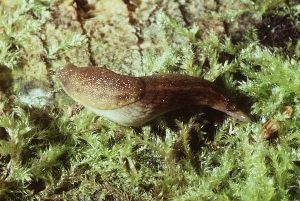 The animal lives in woods and gardens in damp conditions under logs,leaf litter,
rocks and plants.In North-America and Canada.
The animal lives in woods and gardens in damp conditions under logs,leaf litter,
rocks and plants.In North-America and Canada.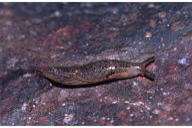 [photo:(c)William Leonard]
[photo:(c)William Leonard]
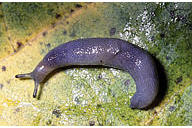 [photo:(c)Kristina Ovaska]
[photo:(c)Kristina Ovaska]
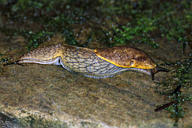
 [photos:(c)William Leonard]
[photos:(c)William Leonard]
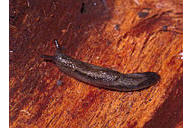 [photo:(c)William Leonard]
[photo:(c)William Leonard]
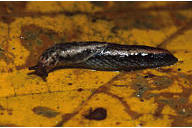 [photo:(c)William Leonard]
[photo:(c)William Leonard]
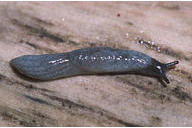 [© 2004 William Leonard]
Distribution:Idaho(USA)
[© 2004 William Leonard]
Distribution:Idaho(USA)
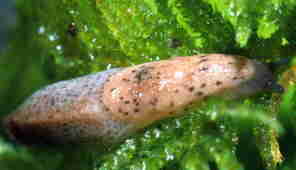 Distribution:Oregon(USA)
[© 2001 William Leonard]
Distribution:Oregon(USA)
[© 2001 William Leonard]
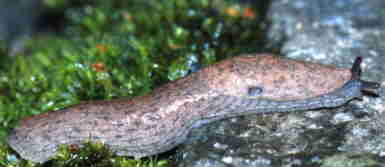 [© 2000 William Leonard]
Distribution:California
[© 2000 William Leonard]
Distribution:California
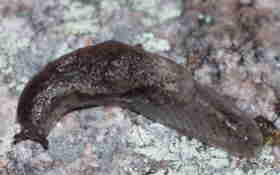 [© 2003 William Leonard]
Distribution:British Columbia,Washington,Idaho,Montana.
[© 2003 William Leonard]
Distribution:British Columbia,Washington,Idaho,Montana.
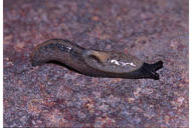 [© 2000 William Leonard]
Distribution:Idaho,Montana(USA).
[© 2000 William Leonard]
Distribution:Idaho,Montana(USA).
 [© 2001 William Leonard]
Distribution:Idaho,Washington,Montana(USA).
Home
[© 2001 William Leonard]
Distribution:Idaho,Washington,Montana(USA).
Home